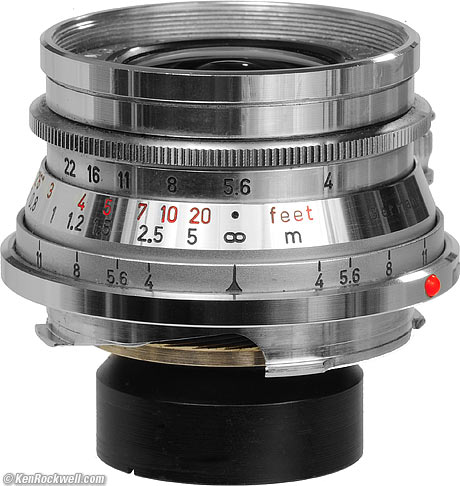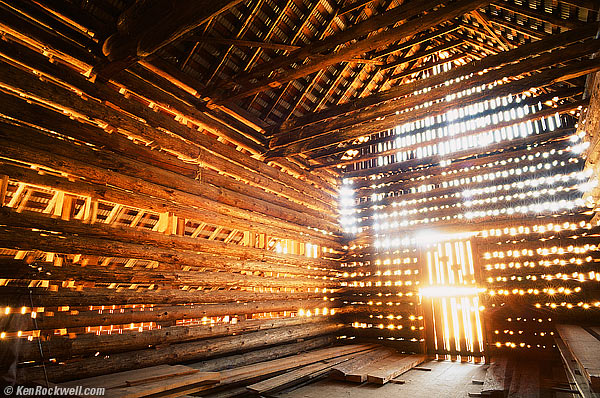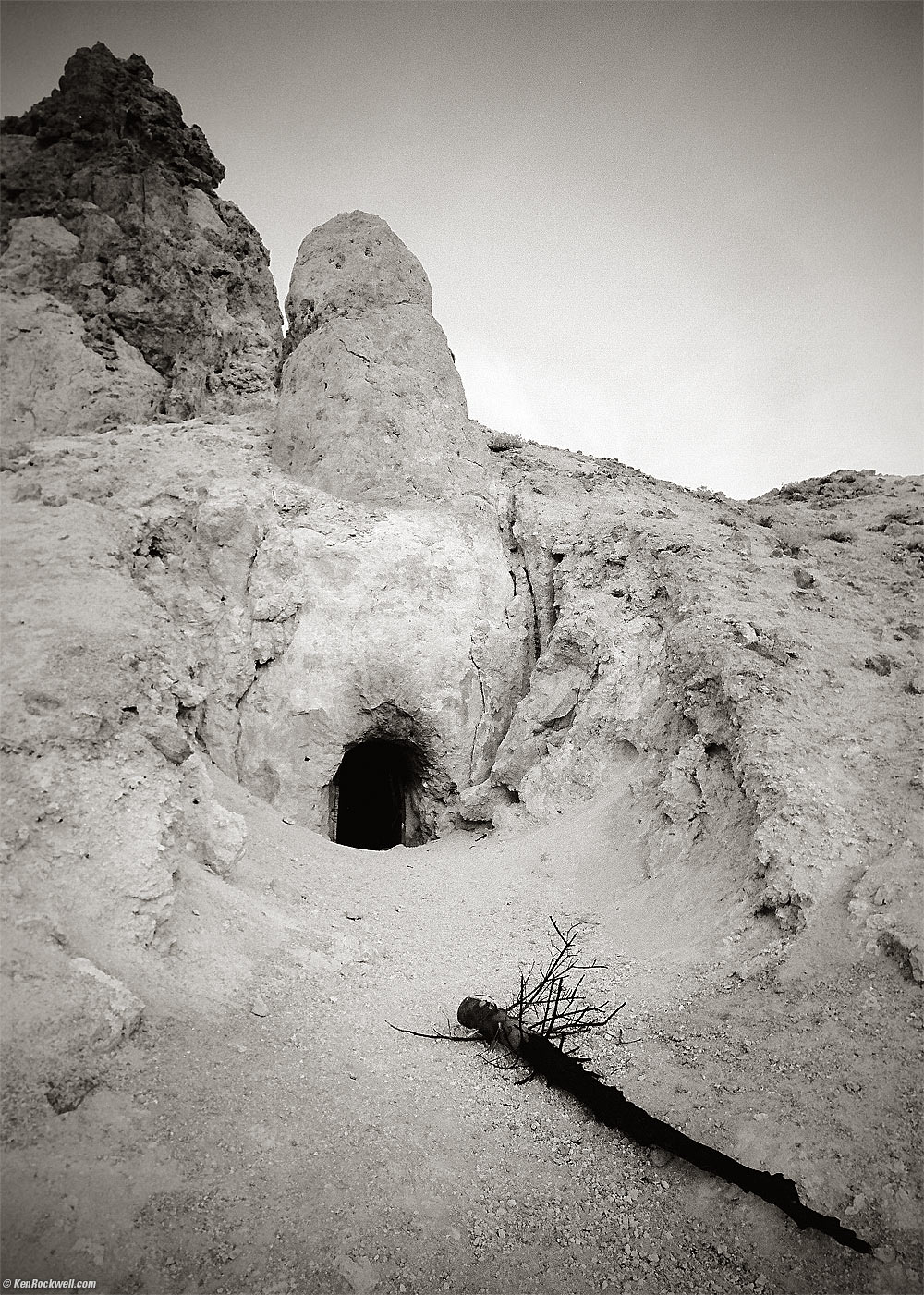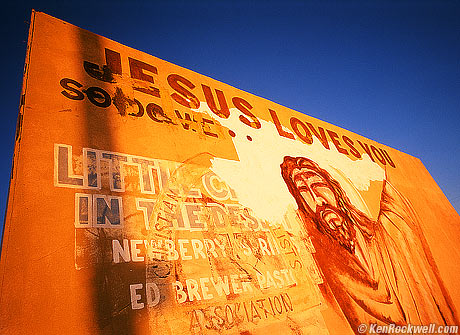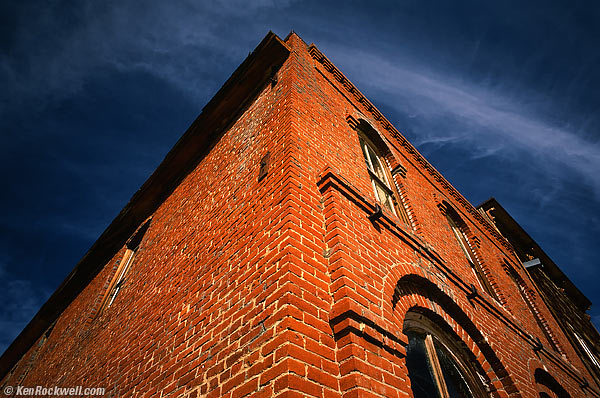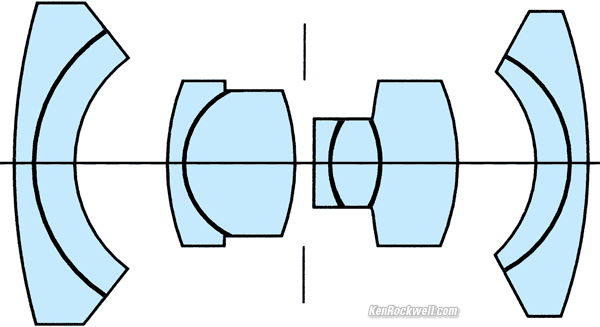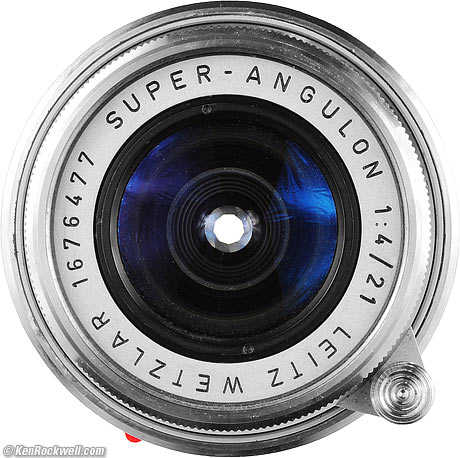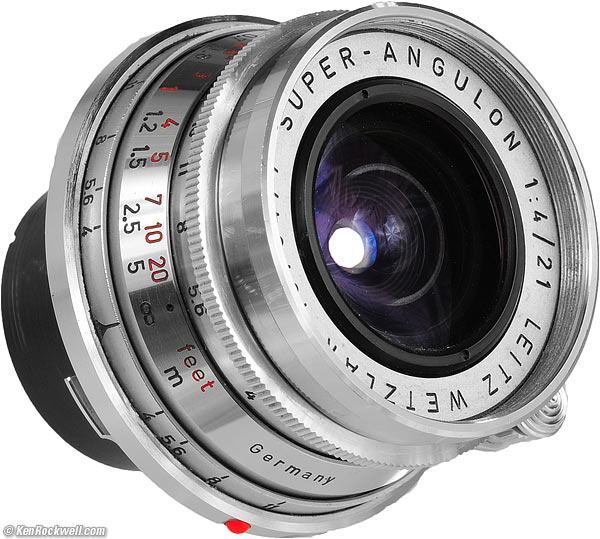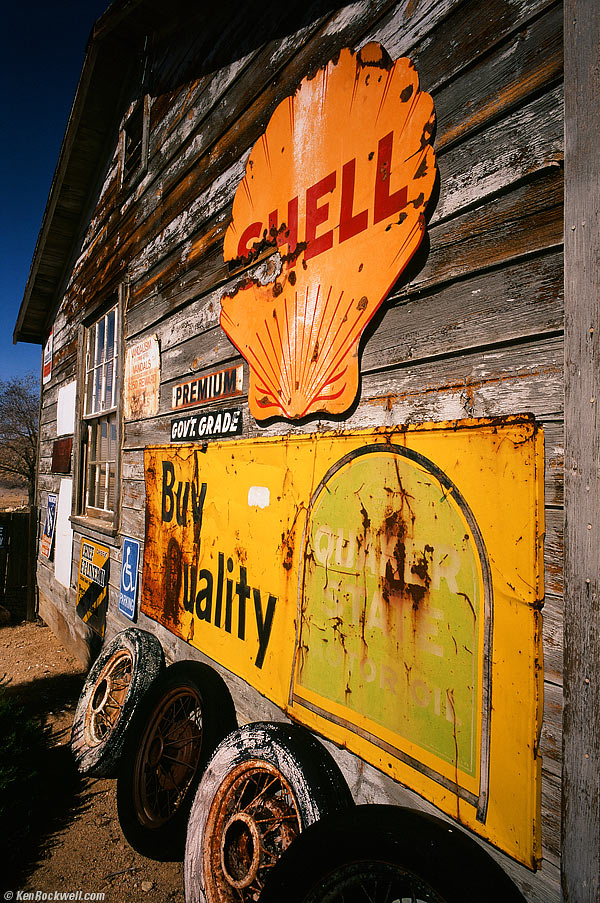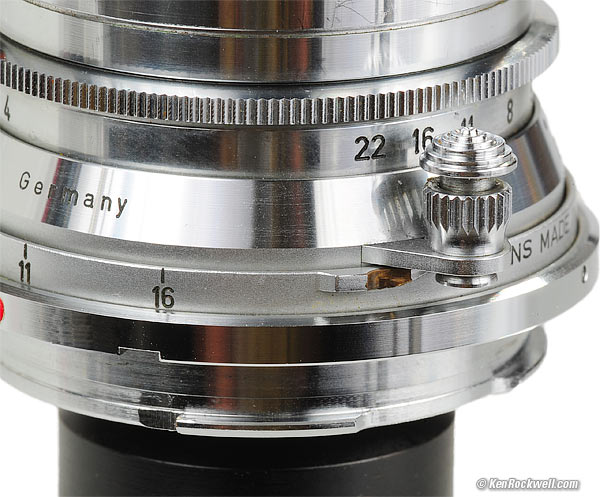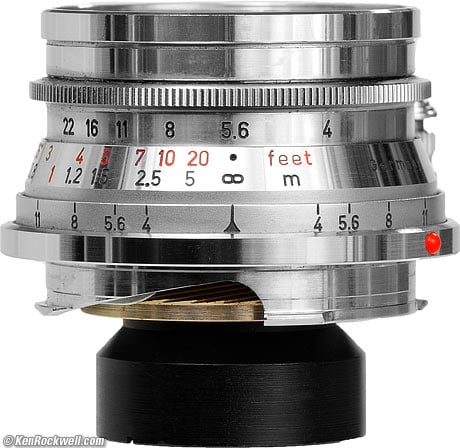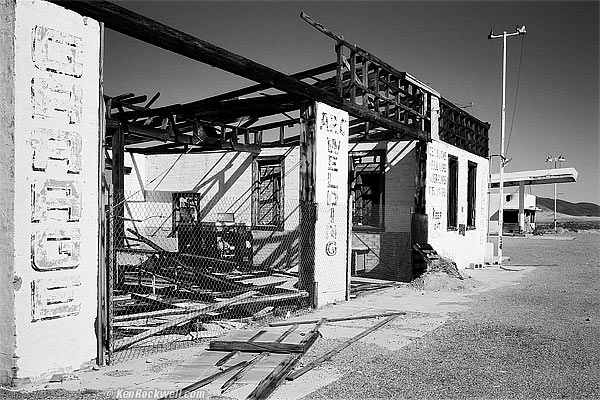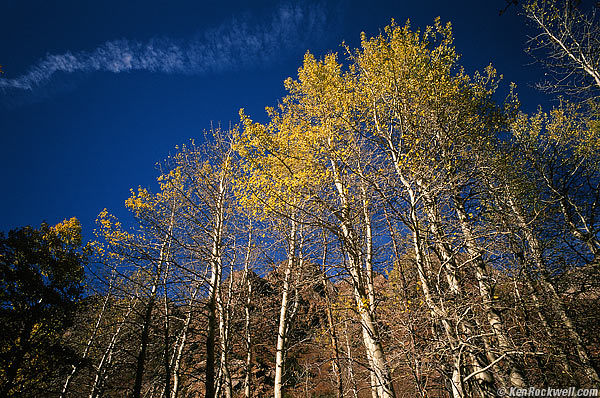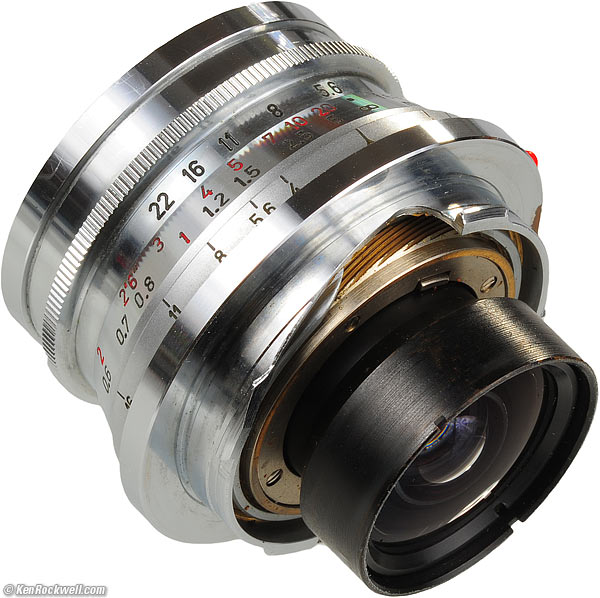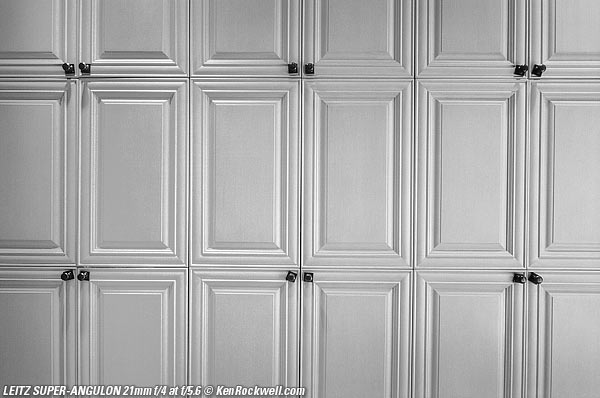Home Donate New Search Gallery How-To Books Links Workshops About Contact
LEICA 21mm f/4
LEITZ SUPER-ANGULON (1958-1963)
© 2010 KenRockwell.com. All rights reserved.
Intro Specs Performance Compared Recommendations
LEICA SUPER-ANGULON 21mm f/4, twice actual size (39mm filters, 8.8 oz./251g, about $1,000 used). Vergrößern. You can get them at this link to them at eBay (how to win at eBay), you also can get them from Adorama. It helps me keep reviewing these oldies when you get yours through these, links, thanks! Ken.
February 2013 LEICA Reviews LEICA Lenses lesser-brand reviews
Guide to all Leica 21mm lenses, 1958-2010
Comparison of all 21mm Rangefinder Lenses
Guide to all Leica 21mm Finders, 1958-2010
Sample Images
Barn. Original Scan.
Route 66, 2010: Welding Shell Jesus
Yosemite, 2009: Barn Triangle Storefront Lundy Lake
Spider Cave, Trona, California, 01 February 2013. (1955 LEICA M3 loaded with Kodak T-MAX 100, LEICAMETER MR-4 at EI 6, 1959 LEITZ SUPER-ANGULON 21mm f/4 mit 39mm LEITZ Red filter, f/11 at one second, casual use of tripod, 30 feet, NCPS process and scan, Perfectly Clear, edge-burned (deliberately vignetted for effect) and split-toned print.) bigger.
Introduction top
Intro Specs Performance Compared Recommendations
|
Adorama pays top dollar for your used gear. I use these stores. I can't vouch for ads below.
|
This LEITZ SUPER-ANGULON 21mm f/4 is the smallest and lightest 21mm lens ever sold by Leica. It's the size of a golf ball, but because it's solid brass, weighs as much as a larger lens (8.8 oz. or 251g).
This tiny lens is unique, and my favorite, because in addition to its high optical performance, it's the only Leica 21mm lens that takes standard 39mm filters and front caps. Therefore you need not trouble yourself carrying a second set of 48mm, 55mm or 60mm filters and caps just for the 21mm lens, as newer 21mm lenses expect.
This SUPER-ANGULON 21mm f/4 is also the first 21mm lens ever sold by Leica. It actually was made by Schneider, and resold by Leica.
The LEICA 21mm f/4 is an exquisite jewel of a tiny lens, with a magnificent 9-bladed diaphragm and complex 9-element design.
Its performance is excellent. Unlike newer lenses, it has no visible distortion, and it is sharp edge-to-edge. Corner falloff of illumination is as to be expected from a symmetrical ultrawide lens, which means that it's great to be used for its artistic effect and saves you from extra edge-burning. Falloff looks great; it's a smooth fall-away from center which gives punch, like this:
Jesus of Barstow. More glorious.
Photographed with Fuji Velvia 50, B+W MRC 39mm 81A filter, 1963 LEICA M3, 1980 LEICAMETER MR-4 CdS light meter, NCPS scan.
I used the moderate falloff to emphasize Jesus' impromptu halo.
What's funny is how so many online experts chastise this lens as having too much falloff, not realizing that this is what all ultrawide lenses designed for rangefinder and view cameras do. This 1950s f/4 lens has the same falloff as today's LEICA ELMARIT-M 21mm f/2.8 ASPH! Online experts aren't photographers.
The only disadvantage to this lens is that its shiny, not matte, chrome finish makes it very difficult to see settings in daylight. It's like trying to look at a chrome bumper. I use the shade of my body to read settings if I'm in direct sunlight.
The SUPER-ANGULON's unique combination of excellent image quality, small size and weight, 9-bladed diaphragm, super close-focus and great system integration by taking the same filters and caps as everything else makes it my favorite. You won't get TTL metering, and otherwise, I love it.
Compatibility top
This LEITZ 21mm f/4 came in both screw (11,002 or SUOON) and bayonet (11,102 or SUOON-M) mounts. Most of the bayonet versions can be dismantled to become screw-mount.
The LEITZ 21/4 SUPER-ANGULON couples to the rangefinder of every LEICA camera, screw or bayonet mount. This isn't some crappy Voigtländer lens.
The LEICA 21mm f/4 SUPER-ANGULON works best on Leica's best camera, the LEICA M3, and just as well as the lesser M2, M4, M4-2, and M4-P.
It also works great on the LEICA M6, LEICA M6 TTL, LEICA M7 and LEICA MP, but these cameras' TTL meters can't read exposure with the SUPER-ANGULON's ultra-low distortion optical design. You'll have to measure exposure traditionally (externally), making it a bit silly to use these lesser cameras for doing what the M3 does better.
Forget it with the M5 and the CL. They use an internal CdS meter-on-a-stick that flips around behind the lens to meter exposure. The M5 and CL can't accept the SUPER-ANGULON because the meter-on-a-stick gets in the way of the rear of the lens.
The SUPER-ANGULON works great on the CLE, but without TTL or Auto metering.
The M9's sensor is deficient in design and therefore won't work well with the SUPER-ANGULON.
The Bodie Triangle, Downtown Bodie, 23 October 2009. original scan.
Photographed with a hand-held 1955 LEICA M3 with a 1959 LEICA 21mm f/4 SUPER-ANGULON and 39mm B+W 81A warming filter, f/9 at 1/100, 10 foot focus distance, Fuji Velvia 50 processed and scanned at NCPS.
If you get out your nerd-o-scope looking at the corners of the original scan for sharpness, be warned that they are farther away and out-of-focus, not unsharp.
LEICA M9: Insufficient top
The SUPER-ANGULON's ultra-low distortion design accentuates the limitations of the LEICA M9's sensor.
The LEICA M9 is not good enough to capture the image from the 21mm f/4 SUPER-ANGULON. The SUPER-ANGULON's specially designed ultra-low distortion optics are optimized for film. The M9 can't keep up with lenses of this quality.
The M9's sensor will tinge the image with false colors on the sides. This is because light from the back of the SUPER-ANGULON hits the M9's sensor (or film) at angles steeper than expected as part of its design.
On the M9, the sensor's microlenses redirect the light to the wrong R, G or B (red, green or blue) sensor wells, and thus interprets the colors incorrectly.
A blank wall snapped on the M9 looks like this:

LEICA M9 Color Shift mit 21mm f/4.
You can see how the M9 sensor wells are aligned vertically, and thus the color shifts are relatively uniform vertically, but vary wildly from left to right.
The M9's sensor is deficient because it cannot respond properly to light which hits it at acute angles, as does the light from this SUPER-ANGULON at the sides.
Leica's more recent 21mm lenses (f/2.8 and ASPH since 1980) use retrofocus designs which move the rear nodal point forward. The light from these newer f/2.8 lenses hits the sides of the sensor at milder angles, with which the sensor can deal. These newer lenses work great with the M9, however these newer lenses are bigger, heaver, and distort more due to their retrofocus designs.
Selecting another 21mm lens' profile won't work. The other profiles are for the newer lenses (1980-) which have their rear nodal points farther away from the sensor, so the corner angles-of-incidence are much easier for the M9's sensor to interpret.
With this SUPER-ANGULON lens, stick to film. If you must use an M9, use the 21mm f/2.8 ASPH instead, which is wonderful on the M9.
I have no idea how well third-party software foolishness can correct these funny colors. The color shifts aren't simply linear shifts in the levels of each of R, G and B. The problem is the light hitting the wrong CCD wells, so what should be going to green winds up going into red or blue instead, and so on. To correct this, one must use channel mixers, matrix math and adjustment layer masks.
History top
The SUPER-ANGULON 21mm f/4 was introduced at Photokina in Cologne, Germany in 1958.
See Guide to all Leica 21mm lenses: 1958 ~ 2010 for the timeline of this and Leica's other 21mm lenses.
Price top
In 2010, the LEITZ 21mm f/4 SUPER-ANGULON sells used for about $1,000. (see How to Win at eBay.)
Its catalog price in 1959 was $1,900, corrected for inflation in 2010 ($240 in 1959 dollars).
Specifications top
Intro Specs Performance Compared Recommendations
Name
Leica calls this the LEITZ SUPER-ANGULON 21mm f/4.
Optics top
Cross-section. Vergrößern.
9 elements in 4 groups.
Classic SUPER-ANGULON symmetrical design, but even more complex than the f/5.6 and f/8 view-camera versions.
Single-coated mostly in blue.
Diaphragm top
LEITZ SUPER-ANGULON 21mm f/4 at f/5.6. Vergrößern.
9 straight blades.
Stops down to f/22.
Full-stop clicks.
There are two sets of aperture scales, each 180º from the other.
Close Focus top
Lens itself: 0.4 meters (16" or 1.3 feet).
Rangefinder coupling: limited by the camera, for instance, it couples to 0.6 meters on a LEICA M7.
Size top
51.00 millimeters (2.008") diameter, maximum (bayonet mount).
27.00 millimeters (1.063") extension from flange.
47.30 millimeters (1.862") overall length.
Filters
39 x 0.5mm screw-in filters (E39).
Attachments
A42 slip-on (42mm outside diameter).
Weight top
8.850 oz. (250.9g), measured.
8.5 oz. (240g), specified.
Chromed brass front cap adds another 0.435 oz (12.3g).
Hood top
The IWKOO (12,502) hood is a puny little trumpet-like thing. It listed for $2.40 in 1959, which is less than $18 with inflation in 2010, and of course it would actually have sold for less than full price.
I can't see it offering any more protection against stray light than a 39mm filter's ring does.
Considering that these hoods today sell for about $350 each, used, I'd forget about it if you don't already have one.
Caps top
The rear cap is very special because it needs to be extra-deep to accept the ultra-low distortion rear optical section.
The front cap is standard E39 or A42.
Front cap
Standard: 14 031 (ORQDO): Chromed brass, slip-over with Hungarian yak felt lining. $6.25 catalog price, corrected for inflation in 2010 ($0.84 in 1959).
Optional screw-in cap: 14 032. $15 catalog price, corrected for inflation in 2010 ($1.95 in 1959).
Today's replacement is the dinky snap-on plastic 14 038.
Rear cap
Bayonet: 14 042 (IROOW). $13.50 corrected for inflation in 2010 ($1.80 in 1959).
Screw mount: 14 048 (OIXMO). $9 corrected for inflation in 2010 ($1.20 in 1959).
Today, you'll have to find third-party rear caps; the SUPER-ANGULON is too deep for Leica's current standard 14 269 cap, which is designed for the retrofocus lenses.
When shooting with the SUPER-ANGULON 21mm, I these third-party rear caps on each of my lenses so that any cap from any lens will fit the 21mm. Otherwise it's more effort to try to find and match one extra-deep cap to the 21mm at every lens change.
Part Numbers top
Lens, complete
Bayonet: 11 102 (SUOON-M).
Screw mount: 11 002 (SUOON).
Hood
12 502 (IWKOO).
Front caps
Standard A42 slip-over: Chromed brass with Hungarian yak felt lining: 14 031 (ORQDO).
Optional 39mm screw-in cap: 14 032.
Rear Caps
Bayonet: 14 042 (IROOW)
Screw mount: 14 048 (OIXMO).
Leather Case
14 565 (ETBIX): catalog price: $18, corrected for inflation in 2010 ($2.40 in 1959).
21mm finder
Contemporary: 12 002 (SBKOO).
Use any 21mm finder you like.
Quality top
Made in Germany.
LEICA SUPER-ANGULON 21mm f/4, twice actual size. Vergrößern.
Performance top
Intro Specs Performance Compared Recommendations
The LEITZ SUPER-ANGULON 21/4 is a wonderful, high-performance and compact lens. It work great as a part of any real LEICA camera system, with the sole disadvantage that TTL metering won't work.
Used on a camera with an external meter like the M3, M2, M4, M4-2, and M4-P, it's my favorite ultrawide lens.
Distortion top
The symmetrical LEICA SUPER-ANGULON 21mm f/4 has no visible distortion. See the straight board running along the left side? With most any other 21mm lens it would curve out.
Hackberry, Arizona, 16 February 2010. enlarge.
Photographed with Fuji Velvia 50, a B+W MRC 39mm 81A filter, a 1963 LEICA M3, a 1950s selenium LEICAMETER MC light meter, and an NCPS scan.
For photogrammetric use, his invisible distortion easily corrects with +1.0 in Photoshop's Lens Distortion Filter for distances between 0.6m and 3m (2-10 feet). I haven't tested for longer distances. Since its invisible, who cares?
Newer lenses, like the LEICA ELMARIT 21mm f/2.8 ASPH, are of retrofocus design, and thus have more distortion and it is more complex to correct.
Ergonomics top
Feel
Although physically tiny, about the size of a golf ball, this lens is as heavy as any of Leica's other small lenses.
It is hewn from solid brass, not flimsy aluminum.
Focus
Focus button, LEITZ SUPER-ANGULON 21mm f/4. Vergrößern.
Focus is with a little button on the bottom of the lens. It locks at infinity to help mounting and unmounting; press it towards the camera to unlock.
One-quarter turn (90º) brings you from infinity to 0.7 meters. It focuses to 0.4 meters.
The entire lens rotates as a unit, except for the bayonet mount. The front filter thread, the aperture ring, the focus ring and the back of the lens all turn together.
The distance scale is shiny chrome, so it's impossible to read in direct sunlight. Read it your body's shadow outdoors.
Depth-of-Field Scale top
LEICA SUPER-ANGULON 21mm f/4, twice actual size. Vergrößern.
The depth-of-field scale is matte chrome, so it's easy to read, even if you can't read the distance scale in most lighting.
Oddly, this is one of the very few 35mm-format lenses I've ever encountered from any manufacturer calculated for anything other than a 0.030 mm circle-of-confusion.
The scale is calculated for an 0.042 mm circle-of-confusion, meaning it indicates one stop larger than every other lens.
In other words, stop down one stop from the scale to get the same indication that every other lens gives. The depth-of-field scale on this 21/4 indicates about 40% more depth-of-field than other 21mm lenses.
To apply my advanced optimum sharpness calculations to determine the aperture which gives the sharpest results, not merely the minimum possible results, use this table:
if the DOF scale reads |
Then use this for optimum sharpness |
f/1 (not shown) |
f/5.6 |
f/2 (not shown) |
f/8 |
f/4 |
f/11 |
f/5.6 |
f/13 |
f/8 |
f/16 |
f/11 |
f/19 |
f/16 |
f/22 |
Thus, if you need everything from infinity to 4.5 feet (1.3m) rendered with the sharpest possible results, the depth-of-field scale indicates f/4. Per my genius calculations above, shoot at f/11 for the sharpest possible results considering both depth-of-field as well as diffraction.
Aperture Setting top
Setting apertures is a bear for two reasons.
First, you can't see the numbers in anything other than diffuse light because of the shiny chrome finish. The photo above is made in diffuse studio light, and it's still hard to see. Forget it in direct sunlight; you have to shield the lens in your own shadow to read it.
The chrome isn't matte chrome, it's shiny like a bumper.
Second, the aperture ring, aperture scale and index dot rotate with the lens as it focuses. As shown above, set to infinity, the aperture index dot is where you expect it, but focused to 2 feet, the index is rotated 90º to the right.
There is a duplicate scale 180º on the other side of the lens. When focused at 16" (0.4m), it's at the top of the lens.
It's not that bad once you get used to looking for it, but compared to Leica's other modern lenses, this is more difficult.
The aperture ring has full-stop clicks. It rotates in the opposite direction from most other Leica lenses.
Apertures are not evenly spaced, but they're close enough.
I certainly prefer the 9-bladed diaphragm and funny aperture ring over the bogus 4-bladed diaphragm of the SUPER-ANGULON 21mm f/3.4 (1963-1980) and 8-bladed diaphragm of today's ELMARIT-M 21mm f/2.8 ASPH.
Finder Blockage top
This tiny 21mm f/4 has no finder blockage.
Unlike other, newer 21mm lenses, you always can see the bottom of your image through the finder, instead of the lens.
Focus top
Focus is always perfect.
Rangefinder cameras have a huge advantage over SLRs with ultrawide lenses.
Falloff (darker corners) top
The LEICA 21mm f/4 SUPER-ANGULON has excellent falloff.
It has falloff similar to every other ultra wide-angle view camera lens, meaning there is plenty of falloff.
It is excellent because the light falls-off smoothly and evenly towards the corners, with no abrupt darkening.
Falloff is a little stronger at f/4, otherwise it doesn't vary much with aperture.
Falloff is the same as the current ELMARIT-M 21mm f/2.8 ASPH, as you can see under Compared.
Flare and Ghosts top
In spite of my best efforts, I can't get the LEICA 21mm f/4 SUPER-ANGULON to show any flare or ghosts.
Bodie, 23 October 2009. Original scan.
Photographed with a hand-held 1955 LEICA M3 with a 1959 LEICA 21mm f/4 SUPER-ANGULON, 39mm B+W 81A warming filter, f/8 at 1/100, 5 meter focus distance, Fuji Velvia 50 processed and scanned at NCPS.
Does anything look amiss in this shot?
No.
See the sun in the top window? While I was there, this refection was too blinding for safety or comfort, yet I got no flare, and no ghosts in the dark windows on the bottom.
How about this shot, inside a barn? It was so dark I needed a four minute exposure (256 seconds), and the holes between the slats on the left are looking out into full daylight!
Barn. Original Scan.
Photographed with a 1955 LEICA M3 and a 1959 LEICA 21mm f/4 SUPER-ANGULON with Hoya 39mm 85C filter, Fuji Velvia 50 processed and scanned at NCPS, 4 minutes exposure at f/8, casual use of tripod.
The stars you see on the bright points of light are 18-pointed sunstars.
Lateral Color Fringes top
There no color fringes anywhere, on film or on the LEICA M9.
The M9's sensor limitations add overall color shifts to the sides, but there are no fringes.
Materials and Construction top
This SUPER-ANGULON is built as it should be.
It is crafted of solid, hard-chromed lathe-turned brass.
All the marking are engraved and filled with paint.
Metering top
Use any LEICAMETER, or a conventional hand-held meter.
For black-and-white, seasoned photographers set exposure from experience. If you're less experienced, make two shots: one at your best estimate, and another with a stop or two more exposure. Of course the LEICAMETER is also excellent for black and white, but not needed.
TTL meters are insufficient for use with the SUPER-ANGULON. The lens' rear elements protrude deeply into the camera body because of the ultra-low distortion design, so TTL meters can't see the shutter curtains.
Yes, you can try to use a TTL meter by compensating for it, typically between 3 and 5 stops, but you're asking for trouble. When you try to use the TTL meter, it's only seeing a small sliver of an off-center part of the image, so you've essentially got a spot meter looking in a random direction. Don't do it.
The SUPER-ANGULON won't mount on the M5 or CL. Their flippy meters-on-a-stick get in the way.
Sharpness top
The LEICA 21mm f/4 SUPER-ANGULON is exquisitely sharp, as are Schneider's large-format SUPER-ANGULONs.
Over the years Leica, like all camera makers, have cast a FUD campaign to scare people away from the old products so that they'll buy new products.
If you ignore the FUD and look at the images, this 21mm is wonderful. Look at the pictures.
Route 66, California, 15 February 2010. enlarge.
Photographed with Kodak T-Max 100, 39mm LEITZ Or orange filter, 1959 21mm f/4 LEITZ SUPER-ANGULON, 1963 LEICA M3, 1950s selenium LEICAMETER MC set to ASA 50, probably about f/11 at 1/50 hand-held, NCPS scan.
I darkened the left side a bit to keep your eyes from wandering; this isn't falloff.
Lundy Lake, 23 October 2009. original scan.
Photographed with a hand-held 1955 LEICA M3 with a 1959 LEICA 21mm f/4 SUPER-ANGULON with a 39mm B+W 81A warming filter, f/9.5 at 1/50, Fuji Velvia 50 processed and scanned at NCPS.
As shot on Fuji Velvia 50 top
It's completely sharp and contrasty in the center at f/4.
The corners are darker, and if you really look way closely in the dark, they are slightly duller at f/4, improving at f/5.6 and f/8.
I can't make an unsharp image with this lens.
As shot on the LEICA M9 (not recommended due to sensor deficiencies)
f/4
Even wide open at f/4, its super sharp and contrasty in the center.
The last 9mm of the sides corners are smearier, but not at all horrible if you're in light so low that you need f/4. If you are at f/4, falloff is strong enough that you aren't likely to notice this.
f/5.6
The corners improve. Now only the last 5mm are smearier.
f/8
Now everything is sharp and contrasty, straight out to the corners.
f/11
The corners are even slightly better at f/11.
f/16
The corners are the same as at f/11, but the center is softer due to diffraction.
f/22
Diffraction softens everything. Like most great lenses, it's softer at f/22 than any other aperture.
Rear, LEICA SUPER-ANGULON 21mm f/4, twice actual size. Vergrößern.
Sunstars top
The 9-bladed diaphragm begets exquisite 18-pointed sunstars.
These are very delicate; I've never seen them stand out except when shooting something crazy like the shot of the barn, above.
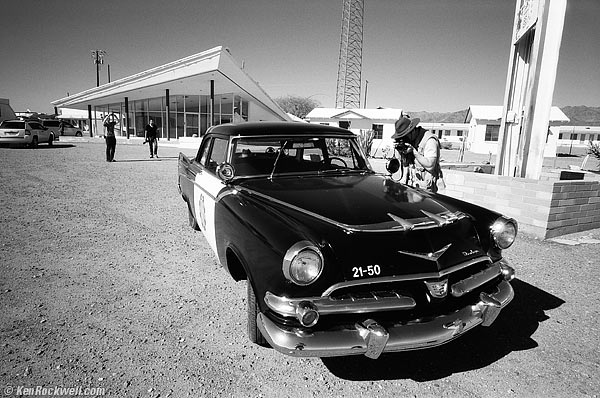
Roy's, Route 66, 15 February 2010, full image. Model: Dave Wyman.
Photographed with Kodak T-Max 100, 39mm LEITZ yellow 1 filter, 1959 21mm f/4 LEITZ SUPER-ANGULON, 1963 LEICA M3, 1950s selenium LEICAMETER MC set to ASA 50, probably about f/11 at 1/125 hand-held, NCPS scan.
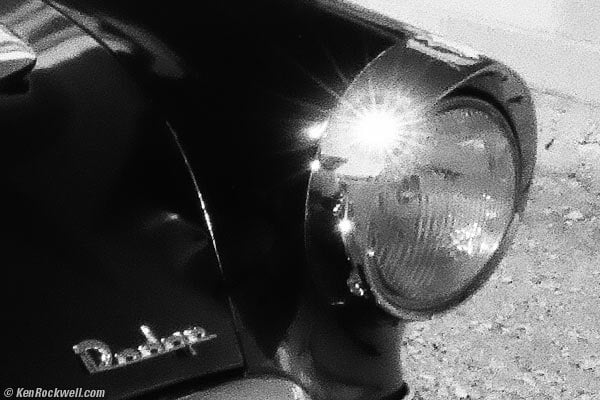
Hard crop from 32 x 48" (85 x 125cm) print, right headlight.
You can see how hokey the 8-pointed sunstars of the current 21mm f/2.8 ASPH look by comparison in the barn shot in my Yosemite gallery.
Compared top
Intro Specs Performance Compared Recommendations
See Guide to all Leica 21mm lenses, 1958 ~ 2010
and Comparison of all 21mm Rangefinder Lenses.
This LEITZ SUPER-ANGULON 21mm f/4 is the smallest and lightest 21mm ever sold by Leica. No 21mm Leica lens focuses more closely, no 21mm Leica lens has less distortion, less finder blockage and none, with the possible exception of the SUMMILUX-M 21mm f/1.4 ASPH, has the excellent 9-bladed diaphragm of this 21mm f/4.
The only reason to buy something newer is because Leica wants to sell it to you, or because you like to use TTL metering.
This 21mm f/4 is better than the newer 21mm f/3.4 because this f/4 lens has a 9-bladed diaphragm instead of the hokey 4-bladed one in the f/3.4, and this f/4 takes standard E39 filters and A42 accessories. The f/3.4 takes 48mm or series VII filters.
This 21mm f/4 focuses twice as close at the current 21mm f/2.8 ASPH, has a superior 9-bladed diaphragm over the simpler 8-bladed diaphragm of the ASPH, and this 21mm f/4 has much less distortion.
Distortion comparison: roll mouse over to compare to the 21mm f/2.8 ASPH:
Distortion: roll mouse over to compare.
Can you see how the center of the ASPH bulges forward, while the SUPER-ANGULON keeps everything straight and flat?
Yes, it's only a slight difference, but it is this 21mm f/4 which is slightly better, while it is the LEICA ELMARIT-M 21mm f/2.8 ASPH which is inferior. This might not be a big deal, but the LEICA ELMARIT-M 21mm f/2.8 ASPH costs four times as much.
These were shot on film. The lighting is flaky, which is why these don't match that well.
How about falloff? I don't see any difference. Remember, the small variations from shot to shot are the lighting. Looking at the right side where the lighting didn't vary much, I can't see any difference in falloff. So where is all the claimed falloff that Leica has used to try to scare us away from this great 21mm f/4 SUPER-ANGULON? Wherever it is, even at over 50 years old, it's the same as today's LEICA ELMARIT-M 21mm f/2.8 ASPH.
The 21mm f/4 is very sharp. Even if you count pixels on an M9 or 3,600 DPI film scans, there still is no visible difference in the central 80% of the image among this f/4 SUPER-ANGULON, the 21mm f/2.8 ASPH or even the 21mm f/4 Voigtländer.
If you're still counting pixels in the corners, the 21mm f/4 Voigtländer is a little sharper in the corners at larger apertures, and the 21mm f/2.8 ASPH is the sharpest, but only in the corners.
Stopped down, they're the same.
The sensor of the M9 is only sufficient for the 21mm f/2.8 ASPH; the other lenses lead to color shifts at the sides on the M9.
Recommendations top
Intro Specs Performance Compared Recommendations
I prefer this LEITZ 21mm SUPER-ANGULON f/4 above all other 21mm lenses for use with classic cameras like the LEICA M3.
For use with TTL meters, like the M6, M6 TTL, MP and M7, I prefer the LEICA ELMARIT-M 21mm f/2.8 ASPH. TTL meters can't meter through the special ultra-low distortion optics of the SUPER-ANGULON.
For use on the M9, use the LEICA ELMARIT-M 21mm f/2.8 ASPH or LEICA SUMMILUX-M 21mm f/1.4 ASPH. The M9's TTL meter can't work with this SUPER-ANGULON, and the M9's sensor can't cope with the SUPER-ANGULON's special optical design either.
Deployment top
For use with color transparency film outdoors, I prefer a 39mm B+W 81A filter.
For B&W outdoors, you want a yellow filter standard, like the B+W 39mm #022, or a B+W 39mm orange filter for more contrast, especially in the skies.
For color print film or digital, you want a Leica 39mm silver-ring UV filter for protection, or go commando.
(the old M8 needed a Leica 39mm silver-ring IR filter.)
Help me help you top
I support my growing family through this website, as crazy as it might seem.
The biggest help is when you use any of these links when you get anything, regardless of the country in which you live. It costs you nothing, and is this site's, and thus my family's, biggest source of support. These places have the best prices and service, which is why I've used them since before this website existed. I recommend them all personally.
If you find this page as helpful as a book you might have had to buy or a workshop you may have had to take, feel free to help me continue helping everyone.
If you've gotten your gear through one of my links or helped otherwise, you're family. It's great people like you who allow me to keep adding to this site full-time. Thanks!
If you haven't helped yet, please do, and consider helping me with a gift of $5.00.
As this page is copyrighted and formally registered, it is unlawful to make copies, especially in the form of printouts for personal use. If you wish to make a printout for personal use, you are granted one-time permission only if you PayPal me $5.00 per printout or part thereof. Thank you!
Thanks for reading!
Mr. & Mrs. Ken Rockwell, Ryan and Katie.
Home Donate New Search Gallery Reviews How-To Books Links Workshops About Contact

